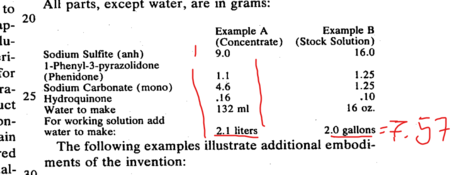Alan Johnson
Subscriber
- Joined
- Nov 16, 2004
- Messages
- 3,247
Low contrast developers for microfilms are discussed in The Film Developing Cookbook 2020 p129-138 and in FDC 1998 p95-102. Amongst commercial developers are Adotech IV, Rollei RLC and Photoformulary TD-3. Dilute "ordinary" developers may work if the film EI is reduced sufficiently from box speed.
H&W Control developer was the basis of this experiment:
A solution was made up with the phenidone and hydroquinone in propylene glycol instead of dissolving them in carbonate solution as per the link.
MODERATOR'S NOTE - See Post #9 for a CCORRECTION to the following recipe:
H&W Glycol:
Part A
Propylene Glycol ......................170ml
Phenidone.....................................3.3g
Hydroquinone..............................0.5g
Propylene Glycol to...................200ml
Part B
Water...............................................170ml
Sodium Sulfite anh....................27.3g
Sodium Carbonate anh...............14g
Potassium Bromide (optional)..0.8g
Water to..........................................200ml
All dissolves with stirring at 40-50C
To make the working solution dilute 1 part A + 1 part B + 14 parts water.
Develop microfilm types12 min 20C with minimal agitation, 10 inversions at start and 2 inversions every 3 minutes.
I tried this on a dull day with Adox CMS20 II at EI=20
In this first test the H&W Glycol showed no evidence of the posterization which sometimes occurred with the original H&W Control in water.
As a one shot developer with a relatively short development time it is quite convenient to use.
H&W Control developer was the basis of this experiment:
A solution was made up with the phenidone and hydroquinone in propylene glycol instead of dissolving them in carbonate solution as per the link.
MODERATOR'S NOTE - See Post #9 for a CCORRECTION to the following recipe:
H&W Glycol:
Part A
Propylene Glycol ......................170ml
Phenidone.....................................3.3g
Hydroquinone..............................0.5g
Propylene Glycol to...................200ml
Part B
Water...............................................170ml
Sodium Sulfite anh....................27.3g
Sodium Carbonate anh...............14g
Potassium Bromide (optional)..0.8g
Water to..........................................200ml
All dissolves with stirring at 40-50C
To make the working solution dilute 1 part A + 1 part B + 14 parts water.
Develop microfilm types12 min 20C with minimal agitation, 10 inversions at start and 2 inversions every 3 minutes.
I tried this on a dull day with Adox CMS20 II at EI=20
In this first test the H&W Glycol showed no evidence of the posterization which sometimes occurred with the original H&W Control in water.
As a one shot developer with a relatively short development time it is quite convenient to use.
Last edited by a moderator:













